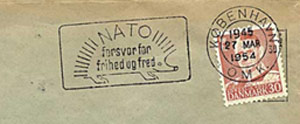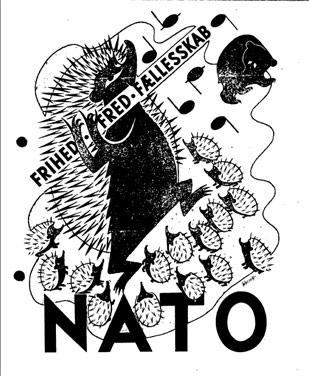Origins
Symbols

The hedgehog: NATO’s lost symbol?
Symbols play an important role in how an organisation presents itself. NATO is considered to have two well-recognised and frequently used symbols: the acronym NATO (OTAN in French), and the NATO star. Far less recognised and almost entirely forgotten is NATO’s third symbol: the hedgehog.
Never officially adopted by NATO, the hedgehog embodies the spirit and determination of Allies to defend themselves against aggressors. The hedgehog is regarded as a peaceful creature yet bristles when attacked.
The earliest mention of the animal was by Supreme Allied Commander Europe (SACEUR) General Dwight “Ike” Eisenhower in January 1951 at a meeting of the Council Deputies (D-R(51)4). In this document, Ike notes that European countries should adopt a “hedgehog” defence, slowing down enemy forces long enough for the full weight of NATO to turn the tide.

a “hedgehog” defence

In July 1951, the Danish Atlantic Association adopted the hedgehog as a symbol for its organisation. The choice was in part a jab towards the Danish communists, who sold dove badges during the Cold War. Atlantic and defence organisations in Norway, Germany and Italy, at various times, used the hedgehog as a symbol of peaceful, but potent defence. The symbol was put on lapels, documents, stamps and other souvenirs.
A special golden hedgehog was commissioned and presented to several important advocates of the Atlantic movement, such as General Eisenhower, Winston Churchill and Secretary General Lord Ismay. You can watch Eisenhower receiving his golden hedgehog in 1951, courtesy of British Pathé.

And here it appears as the cover of a newsletter from September 1959, with 15 hedgehogs (representing the 15 Allies in 1959) working together to fend off a bear, the animal often used to portray the Soviet Union at the time.
The symbol was in use into the 1980s, and the NATO Information Service noted its largely unofficial use by individual countries. Afterwards, the hedgehog as a symbol was dropped both internally and externally by NATO, perhaps due to the changes that occurred with the end of the Cold War. But the hedgehog defence is still referenced, with Secretary General Lord Robertson saying in a speech in 2001 that, “We are still fully capable of safeguarding our territorial security; in that respect we remain – and will always remain – “hedgehogs”.
We are still fully capable of safeguarding our territorial security; in that respect we remain – and will always remain – “hedgehogs”

